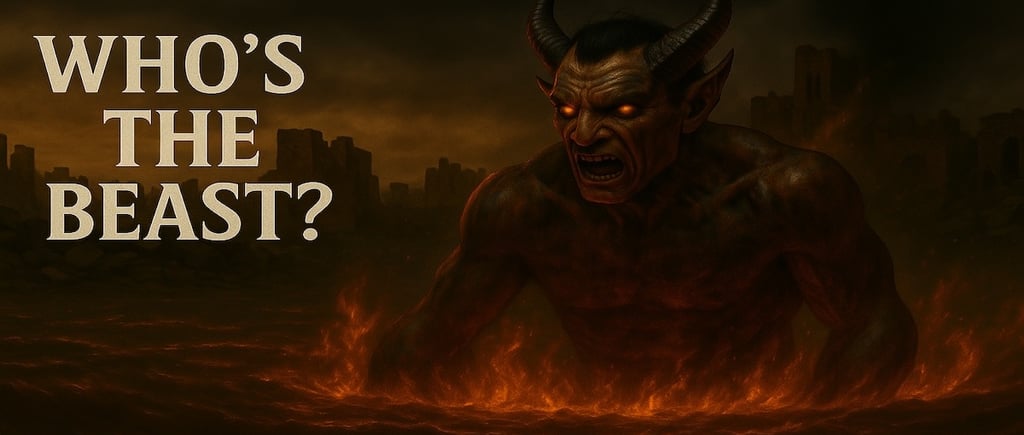Who Was the Beast of Revelation? Rev 20:10, 666, and History Explained
7/2/20253 min read


You’ve Been Lied To About the Beast of Revelation. Here’s What the Bible and History Really Say.
The Beast of Revelation isn’t a future dictator or some Antichrist waiting to microchip the planet. The Bible names the Beast, and history backs it up. Let’s lay out the evidence.
What Revelation Actually Says
Revelation 19:20:
“But the beast was captured, and with it the false prophet who had performed the signs on its behalf… The two of them were thrown alive into the fiery lake of burning sulfur.”
Revelation 13, 17, and 20 describe the Beast as:
Rising from the sea with seven heads and ten horns
Blaspheming God
Waging war on the saints for 42 months
Numbered as 666
Thrown into the lake of fire in Revelation 20:10
This language is taken straight from Daniel 7, where the fourth beast is a kingdom, Rome, crushing everything in its path. Revelation 17 even says the Beast’s “seven heads are seven mountains.” To any first-century reader, that pointed directly to Rome, the city on seven hills.
Was Nero the Beast? (What 666 Really Means)
Revelation 13:18 says, “Let him who has understanding calculate the number of the beast, for it is the number of a man: 666.”
Take “Nero Caesar” in Hebrew letters נרון קסר (Neron QSR) and add up the values. You get 666. Even the early variant 616 works, since that matches the Latin spelling.
Nero’s record fits perfectly:
Claimed divinity and demanded worship
Murdered Christians by the thousands (Tacitus, Annals 15.44)
Turned cruelty into public spectacle
Mocked God by using persecution as entertainment
Tacitus wrote:
“Mockery of every sort was added to their deaths. Covered with the skins of beasts, they were torn by dogs and perished, or were nailed to crosses, or were doomed to the flames and burnt, to serve as a nightly illumination… it was not, as it seemed, for the public good, but to glut one man’s cruelty, that they were being destroyed.” (Annals 15.44)
Nero was the living nightmare of the church. His death left the empire in chaos, the “fatal wound” of Revelation 13:3.
What the Earliest Christians Believed
The first generations of believers were not confused:
Clement of Rome (c. 95 AD) remembered Nero’s slaughter of Peter, Paul, and “a vast multitude” of believers.
Irenaeus (c. 180 AD) said 666 pointed to the Latin power, Rome.
Hippolytus (c. 200 AD) identified Daniel’s fourth beast as Rome and saw Nero as the model for later tyrants.
Legends of “Nero Redivivus” (Nero returning from the dead) filled the Roman world.
They were not talking about microchips or the United Nations. They were talking about Nero.
How Prophecy Got Twisted
The closer you were to AD 70, the clearer the Beast’s identity was. As eyewitnesses died, later writers started speculating. By the third century, the Beast had turned into a future mystery figure. Distance from the events turned certainty into confusion, and confusion is what fuels the prophecy industry today.
Rome, Not the End of the World
Revelation was written to real people under Rome’s shadow.
The book opens with “the time is near” (Revelation 1:3).
The Beast’s reign of 42 months matches the length of the Jewish-Roman War (AD 67–70).
Revelation 17:18: “The woman you saw is the great city that rules over the kings of the earth.” That was Rome.
Jesus said, “This generation will not pass away until all these things take place” (Matthew 24:34). He meant their generation.
The first Christians read Revelation and saw their own world on fire.
Debunking the Myths
Myth: The Beast is a future one-world ruler.
Fact: Nero and Rome fit the description.Myth: 666 is a microchip or global currency.
Fact: 666 is Nero Caesar’s name in code.Myth: Babylon is a future city.
Fact: For John’s readers, Babylon was Rome and apostate Jerusalem.
The Final Verdict (Revelation 20:10)
Revelation 20:10 shows the Devil, the Beast, and the False Prophet thrown into the lake of fire.
Nero and Rome were judged.
The martyrs were vindicated.
Christianity survived.
The Beast is not future. The Beast is history.
Test Everything
Read the Bible. Read Josephus, Tacitus, Eusebius, Clement, Irenaeus. The evidence is there.
If the prophecy has already been fulfilled, why live in fear? Why let confusion rob you of faith?
Jesus already won. The Beast is defeated. Stop chasing monsters. Start trusting the Christ who crushed them.
